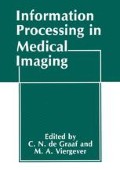Abstract
Three factors which degrade positional information and the quantitative potential of single photon emission computed tomography (SPECT) are finite detector size, Compton scatter, and the detector point spread function (PSF). We focus here on the PSF, which is modelled as a gaussian whose standard deviation depends on the perpendicular distance between the detector and the point being imaged. Thus the PSF is spatially-variant (SVPSF). The PSF is spatially-invariant, of course, within the plane of the detector for a fixed image point-detector distance.
Access this chapter
Tax calculation will be finalised at checkout
Purchases are for personal use only
Preview
Unable to display preview. Download preview PDF.
References
Bracewell, R. N. (1956). Strip integration in radio astronomy, Austr. J. Phys., 9, 198–217.
Bracewell, R. N. (1978), The Fourier Transform and its Applications, McGraw-Hill Book Company, New York.
Clausen, M., Bice, A.N., and Wagner, H.N., Jr. (1985). Resolution of Line Sources in SPECT with 180° sampling (technical note), NUC Compact, 16, 449–454.
Cormack, A. M. (1980). Early two-dimensional reconstruction and recent topics stemming from it, Med. Phys., 7, 277–282.
Eisner, R. L., Gullberg, G.T., Malko, J.A., and Nowak, D.J. (1984). Effects of 180° acquisition on tomographic image quality, J. Nuc. Med., 25, 30–35.
Hsieh, R. C., and Wee, W. G. (1976). On methods of three-dimensional reconstruction from a set of radioisotope scintigrams, IEEE Trans. Sys. Man. Cyb., SMC-6, 854–862.
Loncaric, S., Bice, A.N., Clausen, M., and Wagner, H.N., Jr. (1986). Recovery coefficients for quantitative imaging of small objects by 180° and 360° SPECT, J. Nuc. Med., 27, 1005–1006.
Moore, S. C., and Mueller, S. P. (1986). Inversion of the 3D Radon transform for a multidetector, point-focused SPECT brain scanner, Phys. Med. Biol., 31, 207–221.
Ying-Lie, O. (1983). An ECAT reconstruction method which corrects for attenuation and detector response, IEEE Trans. Nuc. Sci., NS-30, 632–635.
Author information
Authors and Affiliations
Editor information
Editors and Affiliations
Rights and permissions
Copyright information
© 1988 Springer Science+Business Media New York
About this chapter
Cite this chapter
Zeeberg, B.R., Bice, A.N., Loncaric, S., Wagner, H.N. (1988). A Theoretically-Correct Algorithm to Compensate for a Three-Dimensional Spatially-Variant Point Spread Function in Spect Imaging. In: de Graaf, C.N., Viergever, M.A. (eds) Information Processing in Medical Imaging. Springer, Boston, MA. https://doi.org/10.1007/978-1-4615-7263-3_15
Download citation
DOI: https://doi.org/10.1007/978-1-4615-7263-3_15
Publisher Name: Springer, Boston, MA
Print ISBN: 978-1-4615-7265-7
Online ISBN: 978-1-4615-7263-3
eBook Packages: Springer Book Archive

